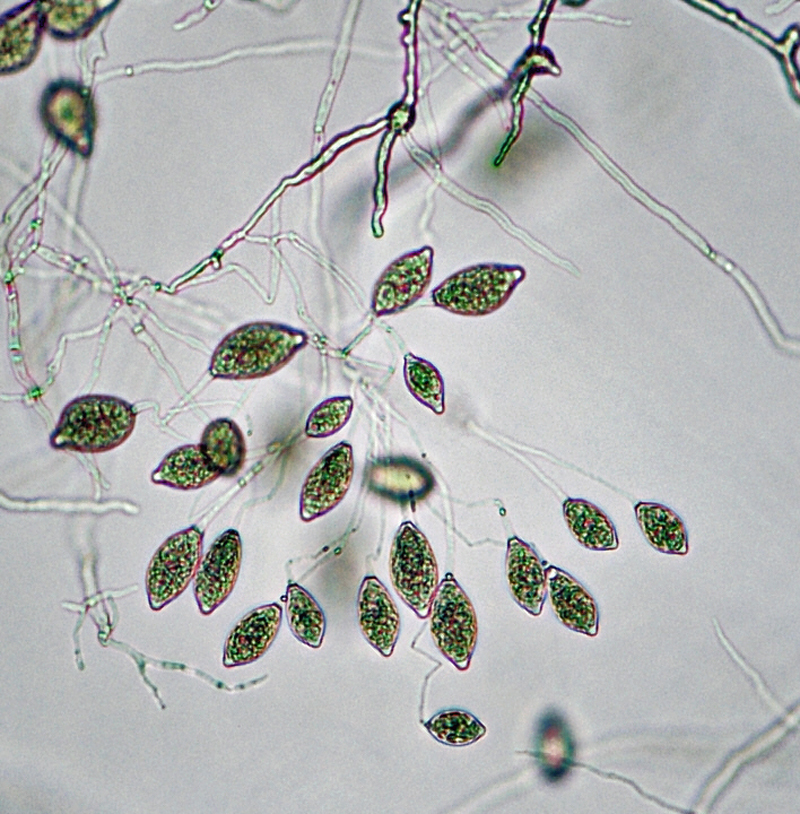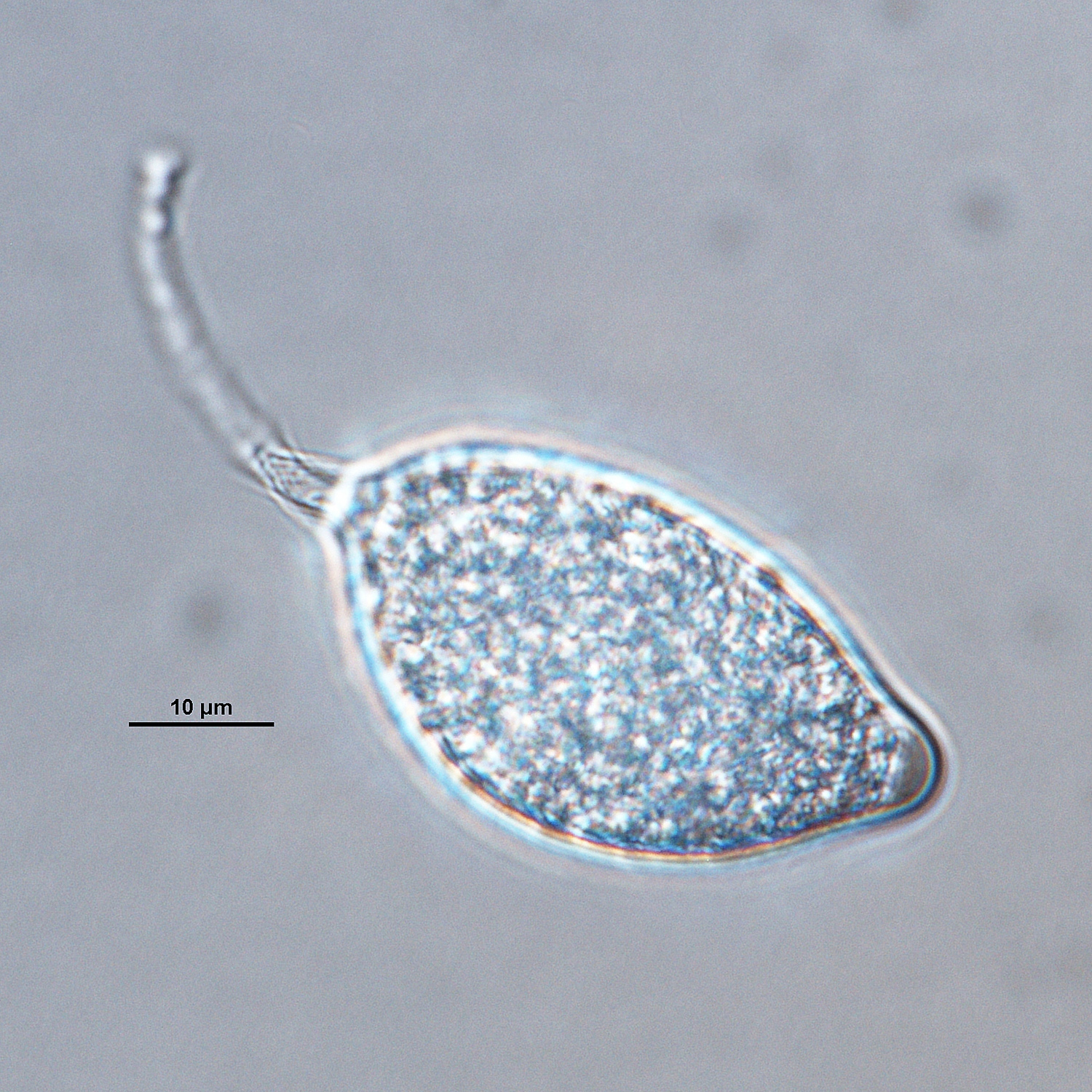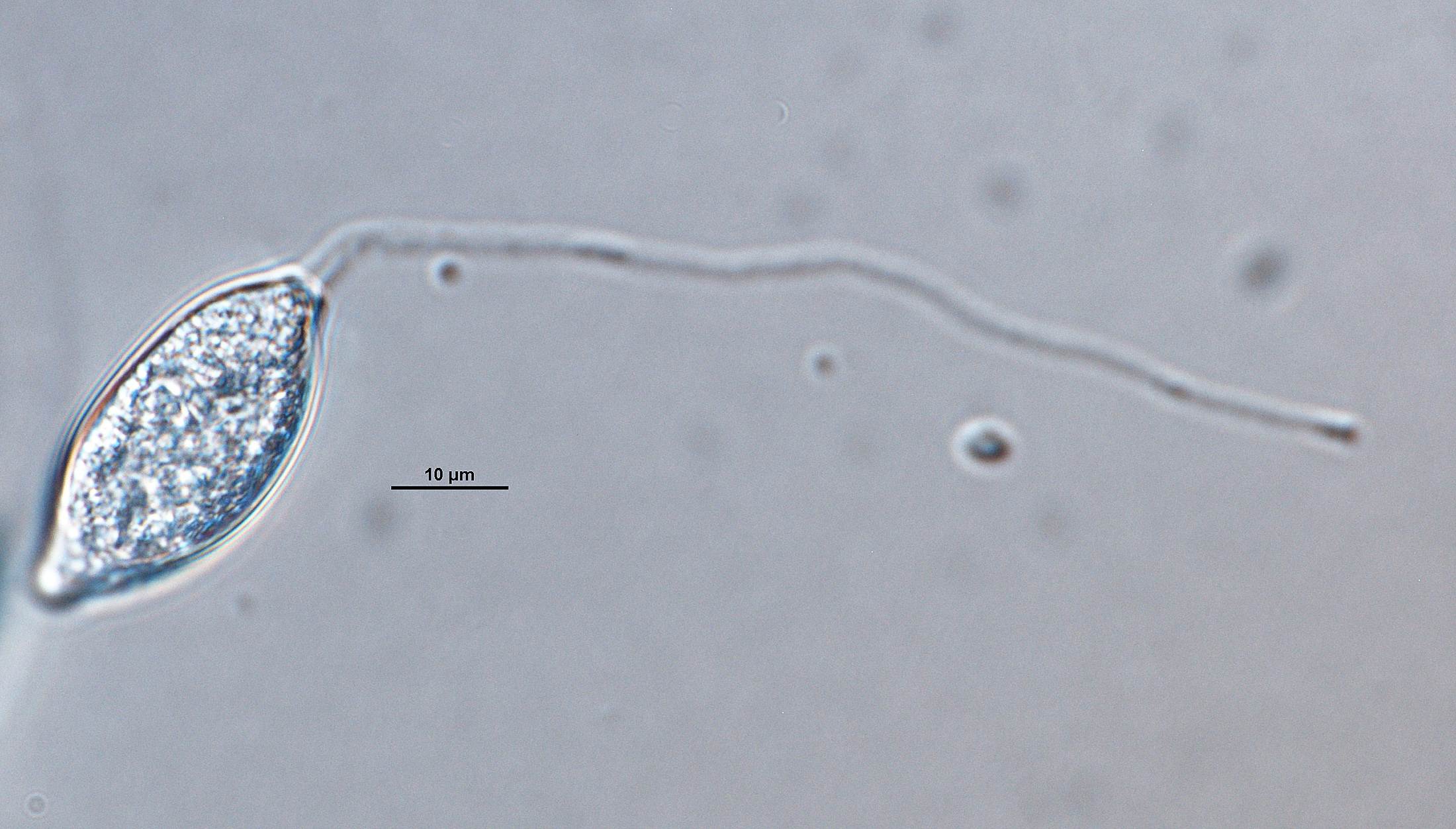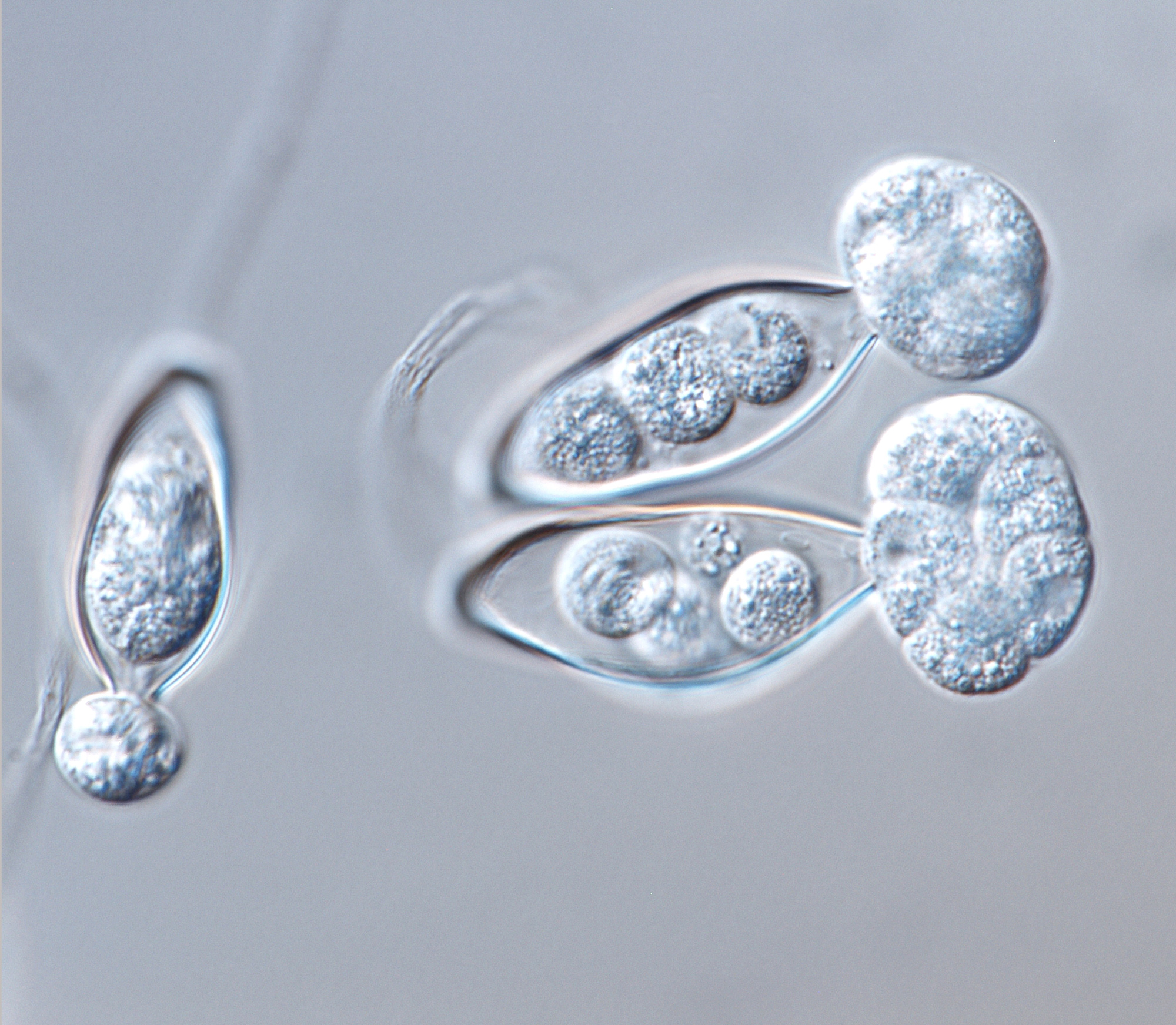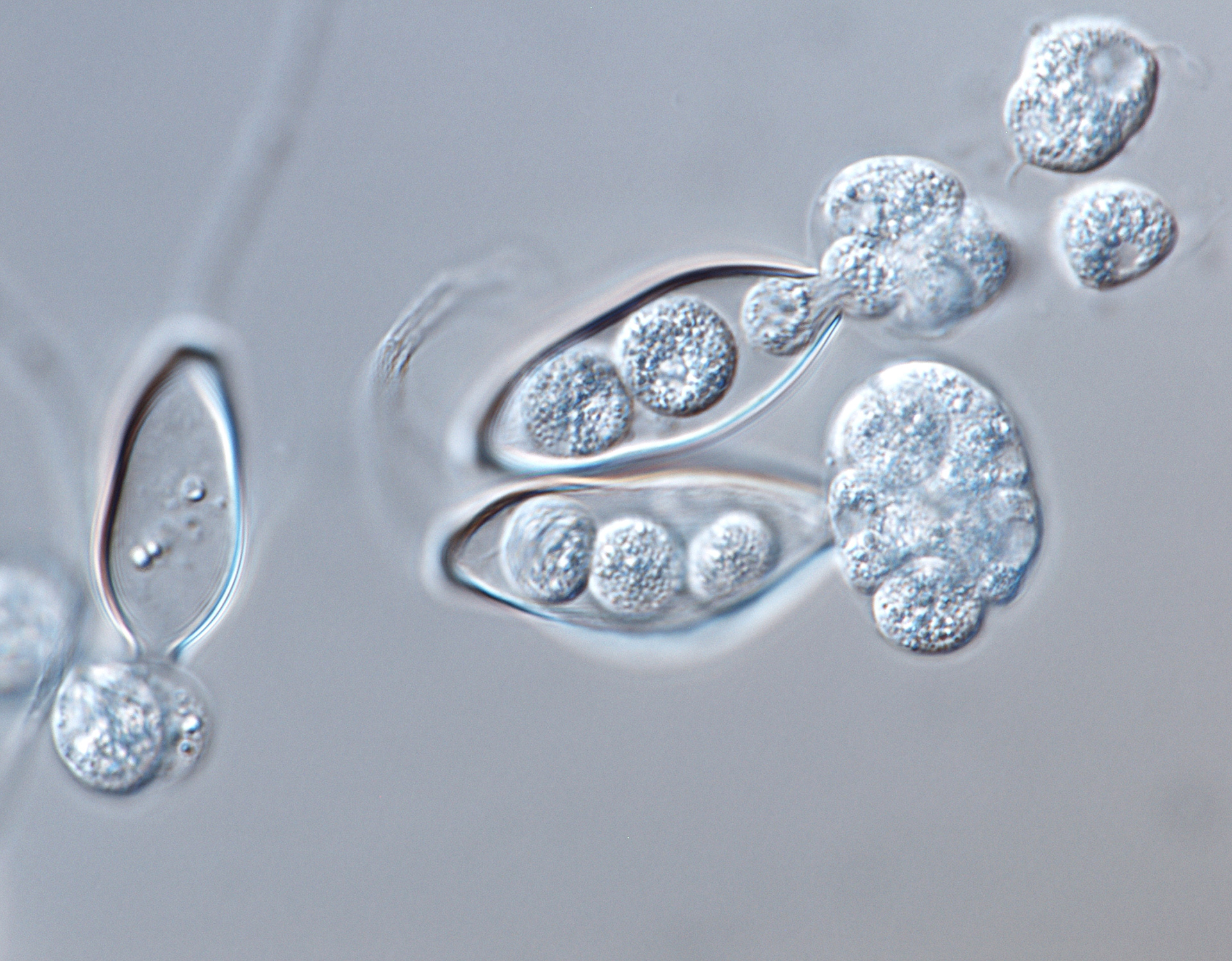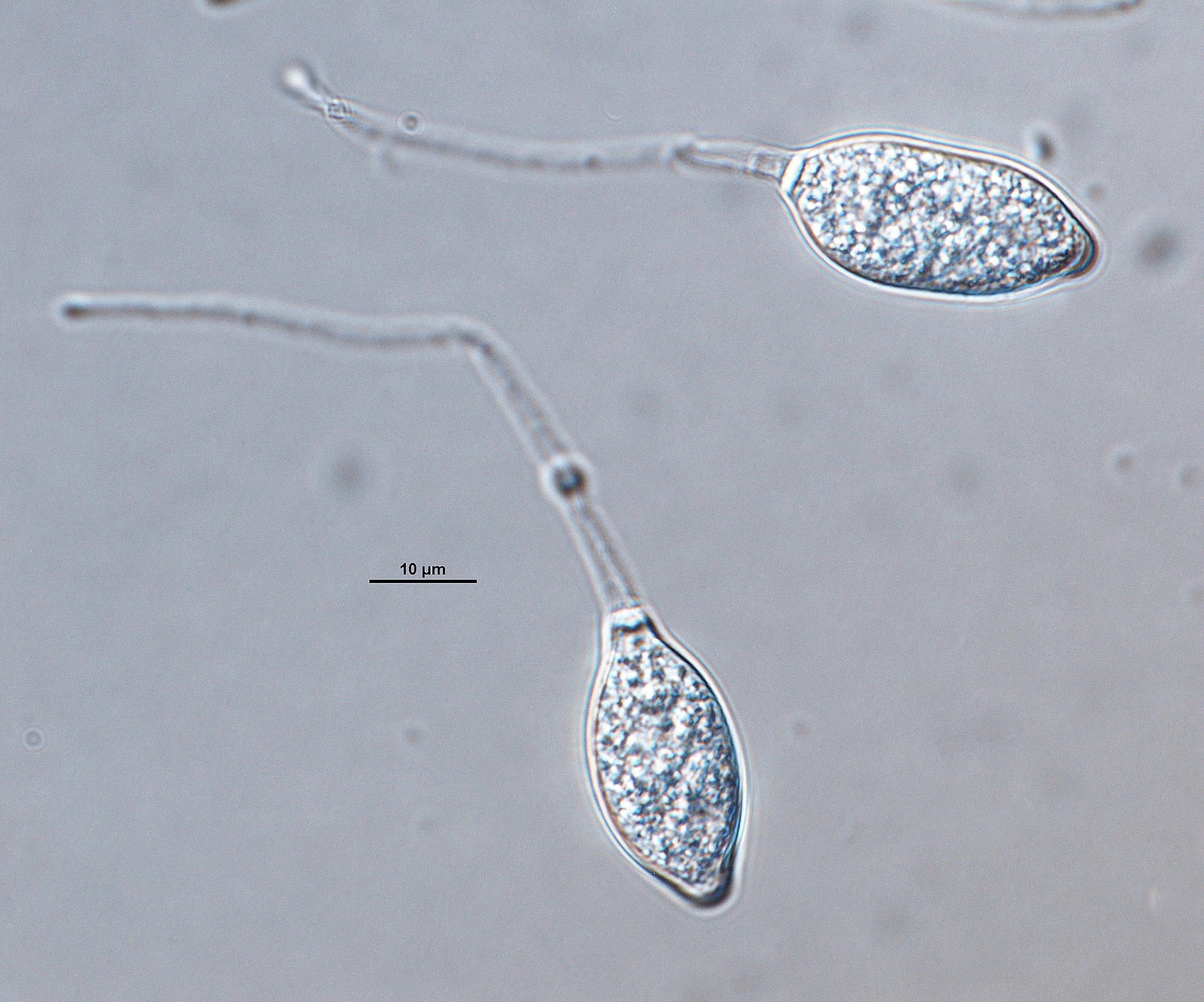Phytophthora tropicalis
|
Phytophthora spp. in subclade 2b: portion of the seven-loci ML phylogeny featuring the type cultures of 212 described species (by T. Bourret). Notice the position of P. tropicalis Ex-type CBS 434.91 = S&T BL 58. Gloria Abad, USDA S&T.
|
|
Phytophthora spp. in subclade 2b: Morphological Tabular key (PDF) and Tabular key legends (PDF) in IDphy2 KEY SECTION. Notice the data of P. tropicalis Ex-type CBS 434.91 = S&T BL 58. Gloria Abad, USDA S&T.
|
|
Phytophthora tropicalis (CPHST BL 58) colonies of the ex-type grown for 7 days on (a) V8® Agar, (b) potato dextrose agar, and (c) malt extract agar; photo by Krysta Jennings and Leandra Knight, USDA-APHIS-PPQ |
|
Phytophthora tropicalis asexual phase of ex-type CPHST BL 58 formed on V8 agar flooded with soil extract (a–g): (a) sporangia originated in umbrella-shaped sporangiophores, (b–e) sporangia papillate, caducous with long pedicels, (f, g) sporangia releasing zoospores; photos by Gloria Abad, USDA-APHIS-PPQ. |
|
Phytophthora tropicalis asexual phase of ex-type CPHST BL 58 formed on V8 agar flooded with soil extract: sporangia originated in umbrella-shaped sporangiophores; photo by Gloria Abad, USDA-APHIS-PPQ. |
|
Phytophthora tropicalis asexual phase of ex-type CPHST BL 58 formed on V8 agar flooded with soil extract: sporangium papillate, caducous with long pedicel; photo by Gloria Abad, USDA-APHIS-PPQ. |
|
Phytophthora tropicalis asexual phase of ex-type CPHST BL 58 formed on V8 agar flooded with soil extract: sporangium papillate, caducous with long pedicel; photo by Gloria Abad, USDA-APHIS-PPQ. |
|
Phytophthora tropicalis asexual phase of ex-type CPHST BL 58 formed on V8 agar flooded with soil extract: sporangia releasing zoospores; photo by Gloria Abad, USDA-APHIS-PPQ. |
|
Phytophthora tropicalis asexual phase of ex-type CPHST BL 58 formed on V8 agar flooded with soil extract: sporangia releasing zoospores; photo by Gloria Abad, USDA-APHIS-PPQ. |
|
Phytophthora tropicalis asexual phase of ex-type CPHST BL 58 formed on V8 agar flooded with soil extract: sporangia papillate, caducous with long pedicels; photo by Gloria Abad, USDA-APHIS-PPQ. |
Name and publication
Phytophthora tropicalis Aragaki & J.Y. Uchida (2001)
Aragaki M and Uchida JY. 2001. Morphological distinctions between Phytophthora capsici and P. tropicalis sp. nov. Mycologia 93: 137–145.
Corresponding author: juchida@hawaii.edu
Nomenclature
from Aragaki and Uchida (2001)
Mycobank
Typification
Type: UNITED STATES OF AMERICA collected from macadamia raceme (Macadamia integrifolia) inflorescence on Macadamia orchard at Keaau, island of Hawaii by M. Aragaki (isolate H245) on 23 January 1975 (HOLOTYPE, CBS, dried culture of CBS 434.91)
Ex-type: CBS 434.91
Ex-type in other collections
(ET) CBS 434.91, NRRL 64471, ATCC 76651 (MCI), WPC P10329, S&T BL 58 (Abad), 35C8 (Hong), p272 (Gallegly)
Molecular identification
Voucher sequences for barcoding genes (ITS rDNA and COI) of the ex-type (see Molecular protocols page)
Phytophthora tropicalis isolate CPHST BL 58 (= P10329 WPC) = ITS rDNA MG865596, COI MH136987
Voucher sequences for Molecular Toolbox with seven genes (ITS, β-tub, COI, EF1α, HSP90, L10, and YPT1
(see Molecular protocols page) (In Progress)
Voucher sequences for Metabarcoding High-throughput Sequencing (HTS) Technologies [Molecular Operational Taxonomic Unit (MOTU)]
(see Molecular protocols page) (In Progress)
Sequences with multiple genes for ex-type in other sources
- NCBI: Phytophthora tropicalis CPHST BL 58
- NCBI: Phytophthora tropicalis P10329
- NCBI: Phytophthora tropicalis CBS 434.91
- EPPO-Q-bank: Phytophthora tropicalis CBS 434.91
- BOLDSYSTEMS: Phytophthora tropicalis OOMYA159-07 [COI-5P:680, ITS:752] = CBS 434.91, OOMYA551-08 [ITS:2233] = CBS 434.91 (barcoding COI & ITS)
Position in multigenic phylogeny with 7 genes (ITS, β-tub, COI, EF1α, HSP90, L10, and YPT1)
Clade clade:
a taxonomic group of organisms classified together on the basis of homologous features traced to a common ancestor
2b
Morphological identification
Colonies and cardinal temperatures
Colony colony:
assemblage of hyphae which usually develops form a single source and grows in a coordinated way
morphology on PDA and MEA with chrysanthemum shape, on V-8A with no distinctive pattern or light chrysanthemum. Minimum temperature for growth 6°C, optimum 27–30°C, and maximum 33°C.
Conditions for growth and sporulation
Sporangia produced on agar and liquid cultures.
Asexual phase
SporangiaSporangia:
sac within which zoospores form, especially when water is cooled to about 10°C below ambient temperature; in solid substrates, sporangia usually germinate by germ tubes
papillatepapillate:
pertaining to the production of a distinct papilla at the distal end of the sporangium (cf. nonpapillate and semipapillate)
; caducouscaducous:
pertaining to sporangia that become dislodged readily (i.e. deciduous) and separate from the sporangiophore (cf. persistent)
with long, often curved pedicels: ovoidovoid:
egg-shaped, with the widest part at the base of the sporangium and the narrow part at the apex
, oboviod, pyriformpyriform:
pear-shaped, with the narrowest part at the base (cf. obpyriform)
, ellipsoidal, or distorted shapes (18–63 µm length x 13–36 µm width), with tapered bases; originated on simple sympodial or umbellate sporangiphores. Hyphal swellings absent. ChlamydosporesChlamydospores:
an asexual spore with a thickened inner wall that is delimited from the mycelium by a septum; may be terminal or intercalary, and survives for long periods in soil
globoseglobose:
having a rounded form resembling that of a sphere
or subglobose (20–33 µm diam.), terminal or intercalaryintercalary:
positioned within a hypha (cf. terminal)
.
Sexual phase
Heterothallicheterothallic:
pertaining to sexual reproduction in which conjugation is possible only through interaction of different thalli (i.e. different mating types) (cf. homothallic)
. OogoniaOogonia:
the female gametangium in which the oospore forms after fertilization by the antheridium
smooth-walled, spherical (27–39 µm diam.); antheridiaantheridia:
the male gametangium; a multinucleate, swollen hyphal tip affixed firmly to the wall of the female gametangium (the oogonium)
amphigynousamphigynous:
pertaining to the sexual stage in which the antheridium completely surrounds the stalk of the oogonium (cf. paragynous)
, spherical, short cylindrical, or ovoidovoid:
egg-shaped, with the widest part at the base of the sporangium and the narrow part at the apex
(13 x 16 µm diam.), sometimes with digitate projections; oosporesoospores:
zygote or thick-walled spore that forms within the oogonium after fertilization by the antheridium; may be long-lived
pleroticplerotic:
pertaining to an oospore that fills the oogonium (cf. aplerotic)
, or slightly apleroticaplerotic:
pertaining to a mature oospore that does not fill the oogonium; i.e. there is room left between the oospore wall and oogonium wall (cf. plerotic)
, spherical (22–36 µm diam.) and thick-walled.
Most typical characters
Phytophthora tropicalis can be differentiated from P. capsici and other species except P. morindae in the production of umbellate sporangiophores and the shape of the caducouscaducous:
pertaining to sporangia that become dislodged readily (i.e. deciduous) and separate from the sporangiophore (cf. persistent)
sporangia with long pedicels.
Specimen(s) evaluated
Phytophthora tropicalis ex-type CPHST BL 58, duplicate of P10329 (World Phytophthora Collection)
Hosts and distribution
Distribution: Pacific Islands (USA: HI); also reported from North America (USA: VA) and Europe (the Netherlands). This species may have been reported before 2001 as Phytophthora capsici; therefore, the full geographic distribution is unclear.
Substrate: leaves, stems, shoots
Disease note: wilt, dieback, shoot death
Host: 14 genera in 12 families
Retrieved February 01, 2018 from U.S. National Fungus Collections Nomenclature Database.
Additional references and links
- SMML USDA-ARS: Phytophthora tropicalis
- EPPO Global Database: Phytophthora tropicalis
- Forest Phytophthora of the world: Phytophthora tropicalis
- CABI Digital Library: Phytophthora tropicalis
- Encyclopedia of Life (EOL): Phytophthora tropicalis
- Index Fungorum: Phytophthora tropicalis
- Google All Phytophthora tropicalis
- Google Images Phytophthora tropicalis
- Google Scholar Phytophthora tropicalis
Fact sheet author
Z. Gloria Abad, Ph.D., USDA-APHIS-PPQ-S&T Plant Pathogen Confirmatory Diagnostics Laboratory (PPCDL), United States of America.

.jpg)

